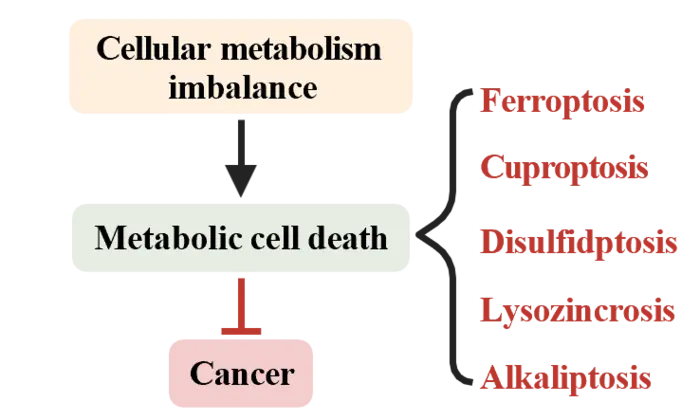
Metabolic cell death in cancer: Ferroptosis, cuproptosis, disulfidptosis, and beyond
The review discusses how metabolic cell death, distinct from traditional forms of regulated cell death like apoptosis, arises from imbalances in cellular metabolism due to nutrient and metal overload or depletion. It emphasizes the therapeutic potential of targeting these unique metabolic vulnerabilities in cancer cells, which frequently undergo metabolic reprogramming.

Credit: Chao Mao, Min Wang, Li Zhuang, Boyi Gan
The review discusses how metabolic cell death, distinct from traditional forms of regulated cell death like apoptosis, arises from imbalances in cellular metabolism due to nutrient and metal overload or depletion. It emphasizes the therapeutic potential of targeting these unique metabolic vulnerabilities in cancer cells, which frequently undergo metabolic reprogramming.
The highlights from the study include:
- Ferroptosis is an iron-dependent form of cell death characterized by the accumulation of lipid peroxides on cellular membranes. It involves the dysregulation of lipid metabolism and iron homeostasis, making cancer cells particularly vulnerable due to their altered metabolic states. The review highlights key enzymes involved in ferroptosis, such as ACSL4 and LPCAT3, and the role of GPX4 in preventing lipid peroxidation. Inhibiting these pathways can induce ferroptosis selectively in cancer cells.
- Cuproptosis is a copper-dependent cell death mechanism, where excessive copper disrupts mitochondrial function, leading to cell death. This pathway can be exploited therapeutically by manipulating copper levels in cancer cells, which often exhibit altered copper metabolism. The review discusses the potential of targeting copper transporters and binding proteins to induce cuproptosis in cancer cells.
- Lysozincrosis is a zinc-dependent form of cell death that involves lysosomal dysfunction and subsequent cell death. It is characterized by the disruption of zinc homeostasis and lysosomal integrity. Therapeutic strategies may include targeting zinc transporters and modulating lysosomal pH to induce lysozincrosis selectively in cancer cells.
- Alkaliptosis is induced by an imbalance in cellular pH, particularly alkalosis, which disrupts cellular metabolism and leads to cell death. This pathway can be targeted by modulating ion channels and transporters involved in pH regulation. The review suggests that alkaliptosis could be a viable strategy for killing cancer cells that rely on specific pH environments for survival.
The review underscores the significance of metabolic cell death pathways, highlighting their potential as novel therapeutic targets in cancer treatment. By understanding the specific metabolic vulnerabilities of cancer cells, therapies can be designed to induce ferroptosis, cuproptosis, disulfidptosis, lysozincrosis, or alkaliptosis selectively, offering new avenues to overcome resistance to conventional therapies. The comprehensive exploration of these pathways not only expands the understanding of cancer biology but also paves the way for innovative treatment strategies that exploit the unique metabolic characteristics of cancer cells. The work entitled “ Metabolic Cell Death in Cancer: Ferroptosis, Cuproptosis, Disulfidptosis, and Beyond ” was published on Protein & Cell (published on Mar. 1, 2024).
Journal
Protein & Cell
DOI
10.1093/procel/pwae003
Method of Research
Systematic review
Subject of Research
Cells
Article Title
Metabolic cell death in cancer: ferroptosis, cuproptosis, disulfidptosis, and beyond
Article Publication Date
1-Mar-2024